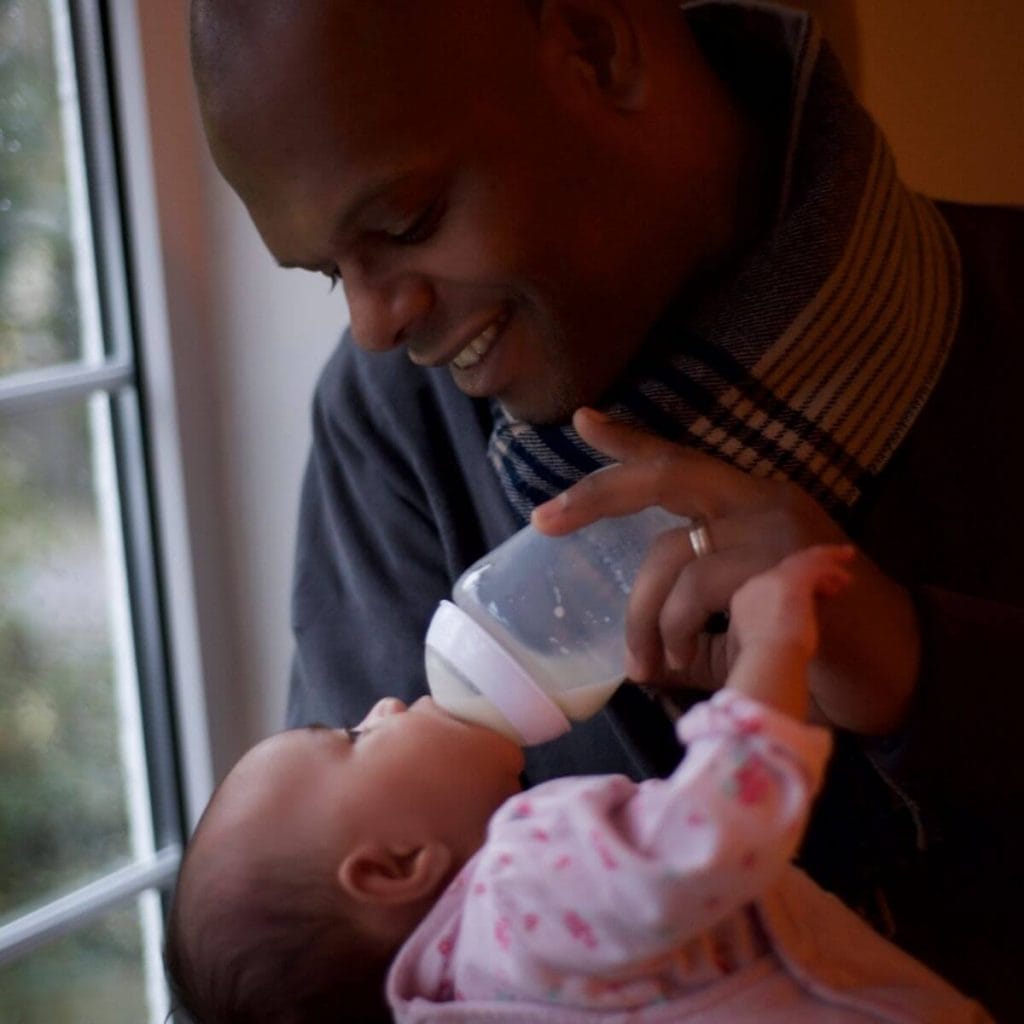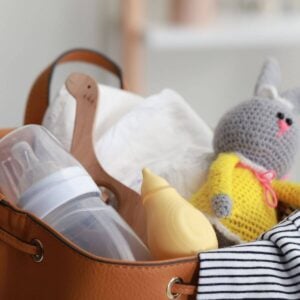Something I wasn’t expecting about becoming a nursing mother is the number of “rules” you have to follow. Along with guidelines about how often you should nurse and what position you should nurse in, there are also mandates about how you should give them a bottle! This is called “pace feeding” baby.
I wrongly assumed I would put my kid on my boob, and that would be the end of the story…oh, how wrong I was.
Despite being a natural, beautiful experience, breastfeeding is not easy. It takes time, effort, and a lifetime supply of lanolin for your cracked and bleeding nipples to get you through.
After figuring out the football hold and dealing with destroyed nips, you might assume that bottle feeding will be a breeze in comparison.
Hold that thought…
With breastfed babies, it’s crucial to make sure you’re preventing nipple confusion once you’re ready to start giving them the occasional bottle.
How does one do this, you might be wondering?
Pace feeding your breastfed baby is a great place to start. Don’t worry if this sounds like a foreign concept. Our team is here to help you figure it out!

This site contains affiliate links, meaning that we earn a small commission for purchases made through our site. We only recommend products we personally use, love, or have thoroughly vetted.
What Does “Pace Feeding Baby” Mean?
Here’s the thing about baby bottles – compared to a mother’s nipple, bottles are the equivalent of a free-flowing fountain. It doesn’t take a lot of effort for your baby to get a mouthful of the good stuff.
Breastfeeding, on the other hand, takes some serious effort.
While on the boob, your little one actually has to work to get the milk out – hence the reason so many new babies fall asleep at the breast.
Now let’s analyze this situation for a moment: if you had the choice to pick between guzzling your nightly glass of wine straight from the glass or having to suck it out of a tiny hole…which would you choose?
If you’re anything like me, there’s no time to play when it comes to the post-bedtime routine glass of wine, so you’d go for the glass every time.
Your baby likely feels the same way.
In most situations, the only difference is that we don’t want them to become solely reliant on the bottle.
While not impossible, exclusively pumping is a challenge.
If you’d like to keep your baby at the breast as long as possible and avoid a tight-knit relationship with your pump, keeping them interested in nursing is ideal.
That’s where paced feeding a baby comes in. By tipping the bottle in specific ways, you can control the amount of milk your baby receives. This mimics the effort they put into regular nursing and will help prevent them from getting confused!

Is Pace Feeding Necessary?
Listen – your baby is your baby. If you don’t feel like you need to practice paced bottle feeding, then that’s your prerogative as a parent. We all need to do what’s best for us and our babies individually!
That said, there are many great benefits to the practice, including:
- Pace feeding baby allows them to have more control over their needs
- Better bonding opportunities between parent and baby, including the partner who isn’t breastfeeding
- Helps breastfed babies alternate between breast and bottle more easily
- Helps prevent overeating
- Due to lower air intake, pace feeding a breastfed baby can help reduce or limit colic symptoms, i.e., body tension and intense bouts of crying
Should You Be Paced Feeding with Formula, Too?
Although you won’t have to worry about the transition from breast to bottle when you’re using formula, pace feeding is still a good option for baby. They can still receive many of the benefits mentioned above, whether they’re drinking breastmilk or formula!
Paced Bottle Feeding & Gas: Does it Help or Hinder?
As bottle feeding often leads to the baby sucking in air while they drink, it’s known to be a common catalyst in infant gas. And it sucks, but there’s no way to prevent this from happening altogether.
If you’re looking to help the situation, though, pace feeding with formula or breastmilk is an excellent way to do it. Since paced feeding a baby forces baby to slow down, not only will they not overeat, but they will also get smaller amounts of air.
It’s actually a common misconception that paced feeding makes gas worse.
Some professionals even recommend switching to the paced feeding method when your baby is struggling with stomach pains.
How Does Pace Feeding Baby Work?
Trust me, I get that the number of child-rearing tips and suggestions available is enough to send any new parent into a fit of parenting stress.
Luckily, pace feeding a baby isn’t hard and is simple to insert into your everyday routine.
Here’s an easy-to-understand step by step guide to paced feeding your baby:
- Find a small bottle (preferably 4oz) that features a slow-flow nipple. Be sure to check out our top picks below!
- When your baby begins exhibiting hunger cues, hold them in a semi-upright position while supporting their head and neck.
- While holding the bottle flat and horizontally, you’ll tickle the baby’s lip with the nipple to encourage a deep latch (much like you do when breastfeeding.)
- Let your baby suck on the empty nipple for a few seconds before slowly tipping the bottle, so the nipple is half-filled with breastmilk or formula. Let them drink for 20-30 seconds.
- After they get a few good sips, gently tilt the bottle back down to give them a break.
- Start over from step 3 until your baby shows signs of fullness.
Helpful Tips for Bottle Feeding Success
Are you looking for ways to make your bottle-feeding experience a success for your breastfed baby? Give the following tips a try:
- Don’t start offering bottles until you’ve established a quality nursing relationship and routine.
- Have someone else give your baby the bottle. If they can sense you and smell you, they might feel frustrated and confused that they can’t nurse.
- Make sure the milk and bottle nipple are warm (not hot!)
- Pick a time to first offer a bottle when your little one is happy and content.
- If you wait until they’re starving to try, they might just get irritated and refuse.

What Are the Best Bottles for Paced Feedings?
Picking the right bottle type is crucial when you pace feed your baby. With so many options on the market, it can be overwhelming to figure out which is best.The following are a few of the top picks among our staff and parenting community:
1.Comotomo Baby Bottle
With more than 34,000 reviews on Amazon, it’s easy to see that the Comotomo baby bottle has made a name for itself within the parenting community.
Not only is this bottle free from harsh materials, such as BPA and phthalates, but it’s also the ideal shape for a breastfed baby. Its wide design closely mimics the look and feel of the breast, which can smooth the transition into bottle feeding.
It even has Anti-Colic vents to help with reduced air intake and consistent milk flow.
2. Dr. Brown’s Slow Flow Anti-Colic Bottles
These Dr. Brown’s baby bottles were a savior for our family. Our eldest daughter struggled with challenging bouts of Colic throughout the first six months of her life.
Nothing we tried seemed to help until a friend suggested these. Their slow flow nipple and fully-vented design were a game-changer.
Upon buying these, we noticed a significant improvement in her tummy troubles.
3. Nanobebe Flexy Silicone Baby Bottle
The Nanobebe Flexy Silicone Baby Bottle is not only one of the best options for pace feeding your baby, but it also has a natural feel that streamlines the transition from breast to bottle.
Reviewers rave about how they struggled to get their baby to take a bottle until they switched to this fantastic design.
4. Munchkin Latch Bottle
Affordable, anti-Colic features, and recommended by feeding and sleep experts – it doesn’t get much better than the Munchkin Latch bottle!
This is one of the top reviewed pace feeding baby bottles on Amazon. It has many great features that make it a favorite infant feeding tool for many parents.
Some users did warn that they did experience some leaks, so be aware if you choose this one.
Protect Your Breast and Bottle Feeding Experience
Whether you’re interested in pace feeding with formula to reduce Colic and gas or you’re looking into pace feeding a breastfed baby, this technique is a valuable option for many new parents.
Sure, there’s no rule stating you have to use this method but with so many great benefits, why not at least give it a chance? That way, when the time comes for a night out with your partner, or it’s time for your baby to enter daycare, your baby’s caregiver can give a bottle, and you can be (relatively) worry-free.
Have you thought about pace feeding your baby? Have you done it in the past? Tell us about your experience!















